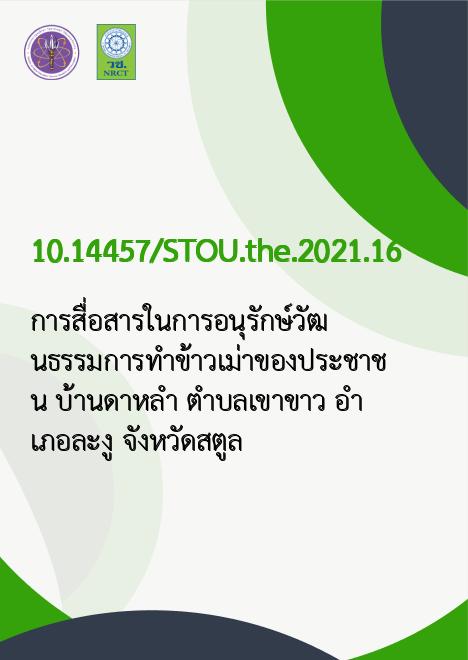
|
การสื่อสารในการอนุรักษ์วัฒนธรรมการทำข้าวเม่าของประชาชน บ้านดาหลำ ตำบลเขาขาว อำเภอละงู จังหวัดสตูล |
|---|---|
| รหัสดีโอไอ | |
| Title | การสื่อสารในการอนุรักษ์วัฒนธรรมการทำข้าวเม่าของประชาชน บ้านดาหลำ ตำบลเขาขาว อำเภอละงู จังหวัดสตูล |
| Creator | สุไหล โพธิ์ดก |
| Publisher | มหาวิทยาลัยสุโขทัยธรรมาธิราช |
| Publication Year | 2564 |
| Keyword | ข้าวเม่า, การสื่อสาร, การอนุรักษ์วัฒนธรรมไทย |
| Abstract | การวิจัยครั้งนี้มีวัตถุประสงค์เพื่อศึกษาการสื่อสารในการอนุรักษ์วัฒนธรรมการทําข้าวเม่าของประชาชนบ้านดาหลํา ตําบลเขาขาว อําเภอละงู จังหวัดสตูลเกี่ยวกับ 1) กระบวนการสื่อสารและ 2) กลยุทธ์การสื่อสาร ผลการวิจัยพบว่า 1) กระบวนการสื่อสาร ประกอบด้วย (1) ผู้ส่งสารที่เป็นผู้นําทางความคิดและเป็นผู้เริ่มต้นวัฒนธรรมการทําข้าวเม่าในหมู่บ้านดาหลําคือ นายม่าหาญ โพธิ์ดก และสมาชิกในครอบครัวนายม่าหาญโพธิ์ดกและได้ขยายวัฒนธรรมการทําข้าวเม่าไปยังกลุ่มผู้ส่งสารที่เป็นแกนนําที่เป็นเครือข่ายญาติพี่น้องใกล้ชิดผู้นําชุมชน ผู้นําศาสนาคณะครูและนักเรียน และชาวบ้านในชุมชนบ้านดาหลํา ซึ่งผู้ส่งสารมีความรู้ความเข้าใจในการสืบทอดวัฒนธรรมการทําข้าวเม่าเป็นอย่างดี (2) เนื้อหาสาร คือ วัฒนธรรมข้าวเม่า ความเป็นมาสภาพแวดล้อม วิถีวัฒนธรรม ภูมิปัญญาชุมชนบ้านดาหลํา และกิจกรรมทําเม่ารวมญาติสืบสารการอนุรักษ์วัฒนธรรมเพิ่มความสัมพันธ์ให้พี่น้องรักกันเหมือนในอดีต (3) ใช้สื่อเสียงตามสาย หอกระจายข่าว การประชุมการอบรม บอร์ดประชาสัมพันธ์แผ่นพับ หนังสือพิมพ์ วิทยุชุมชน โทรทัศน์ เว็บไซต์เฟซบุ๊กและไลน์กลุ่ม (4) กลุ่มผู้รับสารเป็นผู้มาร่วมกิจกรรมการทําข้าวเม่า ประธานจัดกิจกรรมซึ่งเป็นผู้วาราชการจังหวัด นักวิชาการด้านวัฒนธรรม สื่อมวลชน ผู้นําท้องถิ่น นักปกครองท้องที่ ผู้นําชุมชนและสมาชิกกลุ่มวิสาหกิจชุมชน (5) ผลการสื่อสารที่คาดหวัง คือความรักความสามัคคีกนในชุมชนโดยใช้กิจกรรมการทําข้าวเม่าเป็นสื่อ มีการจัดกิจกรรมรวมญาติได้สําเร็จ และทําให้มีการจัดกิจกรรมอยางต่อเนื่องเป็นประเพณีทุกปี 2) กลยุทธ์การสื่อสาร ประกอบด้วย (1) กลยุทธ์เครือข่ายที่ทําให้เกิดพลังจากการรวมกลุ่มเครือข่ายเครือข่ายญาติใกล้ชิด เครือข่ายเพื่อนสนิท เครือข่ายองค์กรภาครัฐและเอกชน และเครือข่ายชาวบ้านชุมชนบ้านดาหลํา (2) กลยุทธ์การสร้างการมีส่วนร่วมของคนในชุมชนเป็นสําคัญ โดยมีการแบ่งหน้าที่ตามความถนัดในการผลิตสื่อและการเผยแพร่ (3) กลยุทธ์สร้างความสมัครใจ ซึ่งมีการใช้การสื่อสารขอความร่วมมือจากสมาชิกของคนในชุมชนด้วยความสมัครใจโดยใช้วิธีการสื่อสารไปยังสมาชิกในชุมชนให้เห็นประโยชน์ร่วมกันและ (4) กลยุทธ์การสื่อสารสองทาง โดยคณะกรรมการผู้จัดกิจกรรมมีการประชุมร่วมกับที่ปรึกษา หารือเพื่อวางแผนการอนุรักษ์วัฒนธรรมการทําข้าวเม่า โดยมีการปรึกษาหารือกันอย่างอิสระเสรี เพื่อสร้างความเข้าใจร่วมกนในการจัดกิจกรรม ส่วนผู้ส่งสารในการสื่อสารกลุ่มใหญ่ผู้นําท้องถิ่น ผู้นําชุมชน จะเป็นผู้สื่อสารในการประสานหน่วยงานภาครัฐและภาคเอกชน เพื่อให้เกิดความร่วมมือในการอนุรักษ์วัฒนธรรมการทําข้าวเม่า || The objective of this research was to study communication for preserving thetradition of making shredded Thai-style instant rice of the Ban Lam Lam people in KhaoKhao Sub-district, La-ngu District, Satun Province in terms of 1) the communicationprocess and 2) communication strategies.This was a qualitative research based on in-depth interviews with twenty-fivekey informants, chosen through purposive sampling from among people directly involvedwith communications to preserve the shredded instant rice making culture. The researchtool was a semi-structured interview form. Data were analyzed by drawing conclusions.The results showed that 1) the communication process consisted of (1) the messagesenders, starting with the ideological leader who initiated the shredded Thai-style instantrice making culture in Ban Da Lam Village, Mr. Maharn Phodok, and his familymembers. Mr. Phodok spread the culture to other core message senders who were hisrelatives, community leaders, religious leaders, teachers and students and other localresidents. All the message senders had a good understanding of shredded Thai-styleinstant rice making culture; (2) the message was the background, environment, culturalpractices, and community wisdom surrounding shredded instant rice culture, as well asthe tradition of relatives joining together to pass down and preserve the culture whileenhancing sentiments of family closeness in the community; (3) the communicationchannels included the public address system, bulletin boards, meetings, training sessions,pamphlets, newspapers, community radio, TV, websites, Facebook and Line groups;(4) The message receivers were people who joined in shredded Thai-style instant ricemaking, the activity chairman, who was the governor, academic experts in culture, themass media, local leaders and administrators, community leaders and members ofcommunity enterprises; (5) the expected results of communication were increasedcohesion and unity in the community as a result of jointly participating in the foodpreparation activities, family reunions, and the founding of an annual tradition.2) Communication strategies consisted of (1) networking, that brought about group forcefrom the joining together of relatives and friends, and government and private sectornetworks as well as the Da Lum community network; (2) community participation inwhich members of the network shared responsibilities according to their aptitude formedia production or dissemination; (3) volunteerism, by using communications to ask forthe voluntary participation of community members after letting them see the benefits ofjoining; and (4) two-way communication, through which the activity managementcommittee met to jointly consult and plan cultural preservation activities centered aroundmaking shredded Thai-style instant rice, with free and open consultation to create amutual understanding for the activities and for communication. The message senders whowere local and community leaders communicated and coordinated with government andprivate sector agencies to create cooperation in the cultural preservation activities. |
| URL Website | https://repository.stou.ac.th |
| Website title | STOU Digital Repository |